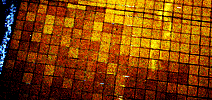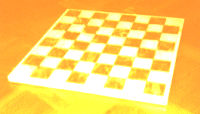Living
Furniture
Living Furniture

Shitty mosaic floor tiles computing cellular automata on the floor of
a subway station.
 FUTANT KING FURNITURE
INC. FUTANT KING FURNITURE
INC.
Briefing Draft.
The goal of the Futant King line of furniture is to make tools and items
that force people into interaction with the abstract matematical lifelike
patterns of cellular automata. It's possible to have a rewarding meeting
with this abstract realm without knowing anything about it beforehand.
It's about non-life lifelike patterns that can react to human presence.
One of the questions that spawned this project was why architecture is
so dull. People and nature are merely bystanders in a 'perfect' architectural
world of blueprints and sketches. The problem is that architecture is
more a source of irritation than perfection. Poorly designed buildings
with walls that keep getting into the way, or public areas that make people
feel uncomfortable. Architecture should be like an interface where life
and lifeless matter meet.
The possibility of embedded computation (and the possibility of developing
this technology by reusing old computers for homebrew projects) makes
it realistic to make furniture and architectural items that run cellular
automata patterns now, not in ten years. A feature of cellular automata
systems is that they can be made reactive (or interactive). By wiring
up sensors that manipulate the state of an individual cell it's possible
to make individual cells react to touch, or whatever weird means of communication
that is chosen. Connecting an old Macintosh, Amiga, or Atari to a set
of lights and sensors, programming the CA and setting up the computer
to load the CA on autoboot will result in a device that fulfills the wishes
of the Futant King Design Laboratories. Futant King Furniture aims to
create a series of rugged blueprints for cellular automata based furniture
during summer/fall 2000.
Why do things in the real world when it's possible to do things in the
safe and protected-mode world of the computer operating system? Perhaps
it's about keeping it real, and making something that lasts longer than
a forgotten computer program. Of course it's possible to frame an old
laptop screen and hang it onto the wall, let it run a cellular automata
software, but then, it'd still be inside the computer world. The Futant
King design project is about literally dissolving the boundaries that
separate machine / life, computer / wiring systems, and human / architecture
from each other.
Imagine a large, wired checkerboard floor installed in a sterile 80:s
atrium or in another public area. The bricks on the floor have two states,
they can either be white or black depending on the state of the neighbouring
bricks. The states are computed according to the rules of a special cellular
automaton called Conway's Games of Life. In this game, a cell with exactly
two neighbors survives. If it has more than 2 neighbors it dies from 'overcrowding',
and if it has less it dies from 'starvation'. The 'dynamic barcode' pattern
below is running a one-dimensional version of this rule, and so is the
'theme applet' of this issue (the one that appears right below the headlines
of all the articles.)
Futant King
Different patterns will run across the Life floor, domino effects initiated
by pressure input from standing or walking humans. A group of kids are
arguing with each other and jumping around in a corner of the floor, trying
to create a stable pattern, and to keep their pattern from being wrecked
by gliding patterns caused by people walking by.

Another usage for cellular automata would be interactive drinking tables
/ chess tables or boards that compute Life patterns depending on where
the drinking glasses are placed.
There's another form of simple interactivity that is being developed
at Futant King R&D and goes by the name "toggling". It's
a non-sequential approach to block-puzzle where the controls are unknown.
The aim is to de-toggle a complicated picture in the shortest possible
time, or in the most beautiful way. There's also toggling without a goal;
toggling for toggling's sake. Like meditation, but in a machinic kind
of way.
In the future we can look forward to people sitting in their Cushicles,
looking at their wallscreen and toggling away at different patterns. Electronics
corporations will give away prizes for those who can de-toggle a particularly
demanding CA advert of say 300x300 cells. Finding the right combination,
or strange attractor that warps the image to a whole again, is a tough
job. Many are called, but few have the knack, free time, and devotion
that it takes to crack an AD-CA. A whole subculture, a subset of otaku
called togglers, dwells under the bright surface of the info-screen. Bulletin
boards sport elaborate hacks and reverse-engineering schemes for the ads,
and potent neural networks that can easily de-toggle them are mentioned
in hushed tones.
- Joel Westerberg
|



